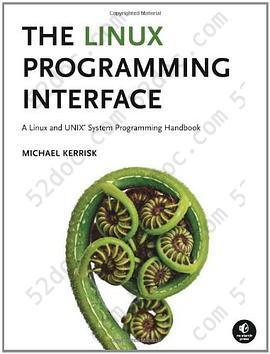注重体验与质量的电子书资源下载网站
分类于: 设计 编程语言
简介

The Linux Programming Interface: A Linux and UNIX System Programming Handbook 豆 9.4分
资源最后更新于 2020-07-24 15:48:24
作者:Michael Kerrisk
出版社:No Starch Press
出版日期:2010-01
ISBN:9781593272203
文件格式: pdf
标签: linux Programming Linux Linux/Unix 编程 计算机 操作系统 Linux|Unix
简介· · · · · ·
The Linux Programming Interface describes the Linux API (application programming interface)-the system calls, library functions, and other low-level interfaces that are used, directly or indirectly, by every program that runs on Linux. Programs that explicitly use these interfaces are commonly called system programs, and include applications such as shells, editors, windowing s...
目录
Preface
Chapter 1: History and Standards
Chapter 2: Fundamental Concepts
Chapter 3: System Programming Concepts
Chapter 4: File I/O: The Universal I/O Model
Chapter 5: File I/O: Further Details
Chapter 6: Processes
Chapter 7: Memory Allocation
Chapter 8: Users and Groups
Chapter 9: Process Credentials
Chapter 10: Time
Chapter 11: System Limits and Options
Chapter 12: System and Process Information
Chapter 13: File I/O Buffering
Chapter 14: File Systems
Chapter 15: File Attributes
Chapter 16: Extended Attributes
Chapter 17: Access Control Lists
Chapter 18: Directories and Links
Chapter 19: Monitoring File Events
Chapter 20: Signals: Fundamental Concepts
Chapter 21: Signals: Signal Handlers
Chapter 22: Signals: Advanced Features
Chapter 23: Timers and Sleeping
Chapter 24: Process Creation
Chapter 25: Process Termination
Chapter 26: Monitoring Child Processes
Chapter 27: Program Execution
Chapter 28: Process Creation and Program Execution in More Detail
Chapter 29: Threads: Introduction
Chapter 30: Threads: Thread Synchronization
Chapter 31: Threads: Thread Safety and Per-Thread Storage
Chapter 32: Threads: Thread Cancellation
Chapter 33: Threads: Further Details
Chapter 34: Process Groups, Sessions, and Job Control
Chapter 35: Process Priorities and Scheduling
Chapter 36: Process Resources
Chapter 37: Daemons
Chapter 38: Writing Secure Privileged Programs
Chapter 39: Capabilities
Chapter 40: Login Accounting
Chapter 41: Fundamentals of Shared Libraries
Chapter 42: Advanced Features of Shared Libraries
Chapter 43: Interprocess Communication Overview
Chapter 44: Pipes and FIFOs
Chapter 45: Introduction to System V IPC
Chapter 46: System V Message Queues
Chapter 47: System V Semaphores
Chapter 48: System V Shared Memory
Chapter 49: Memory Mappings
Chapter 50: Virtual Memory Operations
Chapter 51: Introduction to POSIX IPC
Chapter 52: POSIX Message Queues
Chapter 53: POSIX Semaphores
Chapter 54: POSIX Shared Memory
Chapter 55: File Locking
Chapter 56: Sockets: Introduction
Chapter 57: Sockets: UNIX Domain
Chapter 58: Sockets: Fundamentals of TCP/IP Networks
Chapter 59: Sockets: Internet Domains
Chapter 60: Sockets: Server Design
Chapter 61: Sockets: Advanced Topics
Chapter 62: Terminals
Chapter 63: Alternative I/O Models
Chapter 64: Pseudoterminals
Appendix A: Tracing System Calls
Appendix B: Parsing Command-Line Options
Appendix C: Casting the NULL Pointer
Appendix D: Kernel Configuration
Appendix E: Further Sources of Information
Appendix F: Solutions to Selected Exercises
Chapter 1: History and Standards
Chapter 2: Fundamental Concepts
Chapter 3: System Programming Concepts
Chapter 4: File I/O: The Universal I/O Model
Chapter 5: File I/O: Further Details
Chapter 6: Processes
Chapter 7: Memory Allocation
Chapter 8: Users and Groups
Chapter 9: Process Credentials
Chapter 10: Time
Chapter 11: System Limits and Options
Chapter 12: System and Process Information
Chapter 13: File I/O Buffering
Chapter 14: File Systems
Chapter 15: File Attributes
Chapter 16: Extended Attributes
Chapter 17: Access Control Lists
Chapter 18: Directories and Links
Chapter 19: Monitoring File Events
Chapter 20: Signals: Fundamental Concepts
Chapter 21: Signals: Signal Handlers
Chapter 22: Signals: Advanced Features
Chapter 23: Timers and Sleeping
Chapter 24: Process Creation
Chapter 25: Process Termination
Chapter 26: Monitoring Child Processes
Chapter 27: Program Execution
Chapter 28: Process Creation and Program Execution in More Detail
Chapter 29: Threads: Introduction
Chapter 30: Threads: Thread Synchronization
Chapter 31: Threads: Thread Safety and Per-Thread Storage
Chapter 32: Threads: Thread Cancellation
Chapter 33: Threads: Further Details
Chapter 34: Process Groups, Sessions, and Job Control
Chapter 35: Process Priorities and Scheduling
Chapter 36: Process Resources
Chapter 37: Daemons
Chapter 38: Writing Secure Privileged Programs
Chapter 39: Capabilities
Chapter 40: Login Accounting
Chapter 41: Fundamentals of Shared Libraries
Chapter 42: Advanced Features of Shared Libraries
Chapter 43: Interprocess Communication Overview
Chapter 44: Pipes and FIFOs
Chapter 45: Introduction to System V IPC
Chapter 46: System V Message Queues
Chapter 47: System V Semaphores
Chapter 48: System V Shared Memory
Chapter 49: Memory Mappings
Chapter 50: Virtual Memory Operations
Chapter 51: Introduction to POSIX IPC
Chapter 52: POSIX Message Queues
Chapter 53: POSIX Semaphores
Chapter 54: POSIX Shared Memory
Chapter 55: File Locking
Chapter 56: Sockets: Introduction
Chapter 57: Sockets: UNIX Domain
Chapter 58: Sockets: Fundamentals of TCP/IP Networks
Chapter 59: Sockets: Internet Domains
Chapter 60: Sockets: Server Design
Chapter 61: Sockets: Advanced Topics
Chapter 62: Terminals
Chapter 63: Alternative I/O Models
Chapter 64: Pseudoterminals
Appendix A: Tracing System Calls
Appendix B: Parsing Command-Line Options
Appendix C: Casting the NULL Pointer
Appendix D: Kernel Configuration
Appendix E: Further Sources of Information
Appendix F: Solutions to Selected Exercises








